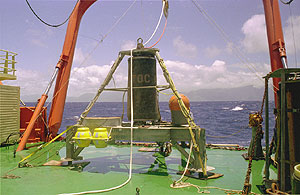ATOC Transmission
ATOC Transmission Sounds
Description

ATOC HX-554 acoustic source (75 Hz) on the DSVSS Laney Chouest ready for deployment off Kauai during July, 1997. The acoustic source is a large ceramic cylinder mounted on a frame. Electrical current passed through the cylinder will cause it to expand and contract, creating the 75Hz sound waves for the ATOC project. Photo Credit: Scripps Institution of Oceanography.
Acoustic tomography uses the travel time of sound in the ocean to measure the temperature of the ocean over large areas. The ATOC (Acoustic Thermometry of Ocean Climate) project measured temperatures in the North Pacific Ocean with acoustic tomography.
The sound source used in the ATOC project did not make sound all the time. It made sound for 20 minutes every 4 hours on every fourth day. This resulted in six 20 minute transmissions for a total of 2 hours every 4 days. The ATOC source used at Hawaii was sending a sound out at a frequency centered on 75 Hz with a bandwidth of 35 Hz (meaning the sound has a frequency range of 57-92 Hz). The ATOC project used a low frequency source because low frequencies travel farther in the ocean than high frequencies. The ATOC source was also used by the North Pacific Acoustic Laboratory (NPAL). The NPAL experiment, and transmissions from the ATOC source, ended in 2006.